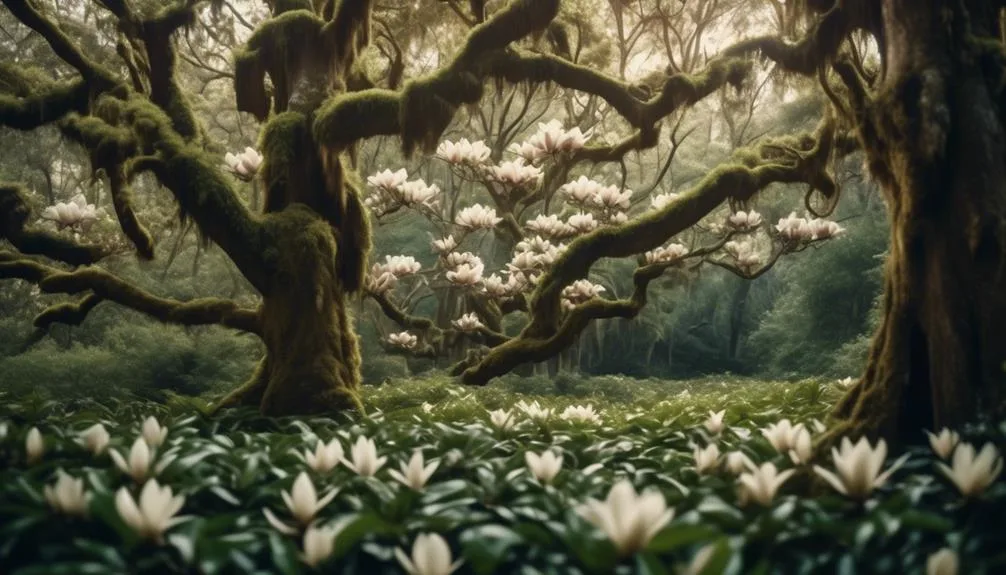Magnolia trees aren't just limited to the American South. They actually grow in various places around the world, from the lush forests of Asia to the diverse landscapes of Central and South America.
Understanding the history and natural habitats of these iconic trees can be quite intriguing. It's interesting to explore how they have spread across different continents and adapted to different environments.
There's a lot to discover about the wide-ranging natural habitat of magnolia trees.
North America
In North America, magnolia trees can be found in a diverse range of environments, from the coastal regions of the Southeast to the mountainous areas of the West.
Several magnolia tree species, such as the Southern magnolia (Magnolia grandiflora) and the Sweetbay magnolia (Magnolia virginiana), thrive in these varied habitats.
The habitat distribution of magnolia trees in North America is influenced by factors like temperature, precipitation, and soil type.
The Southern magnolia, for example, favors the warm, humid climate of the Southeast, while the Sweetbay magnolia can be found in wetlands and along the coastal plains.
Additionally, some magnolia species, like the Bigleaf magnolia (Magnolia macrophylla), are more commonly found in the Appalachian Mountains, where they flourish in the rich, moist soils and cooler temperatures.
Asia
Nestled within the diverse landscapes of Asia, magnolia trees grace the continent with their elegant blooms and distinctive foliage. In Asia, various magnolia tree species thrive in their native habitats, adding natural beauty to the region. The continent boasts a rich diversity of magnolia species, each with its own unique characteristics and charm. From the Himalayas to the forests of Japan, magnolia trees can be found in a range of environments, from alpine regions to subtropical climates.
The native habitats of magnolia tree species in Asia include:
- Lush mountainous areas
- Temperate forests
- Coastal regions
- Wetlands
These diverse environments contribute to the wide array of magnolia tree species found across Asia, making it a fascinating continent for nature enthusiasts and botanists alike.
Central America
Amidst the vibrant landscapes of Central America, magnolia trees flourish, adorning the region with their exquisite blossoms and unique foliage. Central America is home to several species of magnolias, adding to the region's rich biodiversity. The temperate climate and diverse topography provide ideal conditions for these majestic trees to thrive. From the cloud forests of Costa Rica to the highlands of Guatemala, magnolia species such as Magnolia yoroconteensis and Magnolia mayae can be found, each contributing to the natural beauty of the area. The stunning presence of magnolia trees in Central America attracts nature enthusiasts and botanists alike, offering a glimpse into the fascinating world of these remarkable flowering plants.
| Magnolia Species | Location | Notable Feature |
|---|---|---|
| Magnolia yoroconteensis | Honduras | Large, fragrant flowers |
| Magnolia mayae | Guatemala | Rare, endemic species |
| Magnolia sharpii | Panama | Striking pink flowers |
South America
Embracing the diverse landscapes of South America, a variety of magnolia species thrive, adding splendor to the continent's natural beauty. Within South America's diverse ecosystems, unique species of magnolia trees can be found, each contributing to the rich tapestry of the region.
Here are some fascinating facts about magnolia trees in South America:
- Magnolia dodecapetala, also known as the Andean magnolia, is found in the Andes Mountains, boasting large, fragrant flowers.
- The Magnolia oviedoensis, a rare species native to Ecuador, features stunning pinkish-purple blooms.
- In the Amazon rainforest, the Magnolia amazonica stands out with its enormous, creamy-white flowers and sweet citrus scent.
- The Magnolia liliflora, native to Brazil, displays striking, tulip-shaped flowers and thrives in the lush, tropical environment.
South America's diverse magnolia trees truly showcase the continent's natural wonder.
The Caribbean
The Caribbean is renowned for its pristine beaches, crystal-clear waters, and vibrant culture, making it a captivating destination for travelers seeking tropical paradise. Within this enchanting region, several species of magnolia trees can be found, adding to the area's natural beauty.
Caribbean magnolia species, such as Magnolia cubensis and Magnolia portoricensis, play a crucial role in the region's ecological balance, providing habitats for diverse wildlife and contributing to the overall biodiversity. However, these magnificent trees face threats from deforestation, climate change, and invasive species.
Conservation efforts in the Caribbean are focused on preserving the natural habitats of magnolia trees, raising awareness about their ecological importance, and implementing measures to sustain their populations. By supporting these initiatives, visitors and locals alike can contribute to the protection of the Caribbean's precious magnolia species for future generations to enjoy.
Conclusion
So whether you find yourself in North America, Asia, Central America, South America, or the Caribbean, the natural beauty of magnolia trees can be spotted in various climates and regions.
Wherever they thrive, these unique trees add a touch of natural wonder, enriching their surroundings with their stunning presence.

My interest in trees started when I first saw the giant sequoias in Yosemite.
I was a teenager then, and I remember thinking, “I need to learn more about this.”
That moment stuck with me.
A few years later, I went on to study forestry at Michigan Tech.
Since graduating, I’ve worked in a mix of hands-on tree care and community education.
I’ve spent over ten years helping people understand how to plant, maintain, and protect the trees in their neighborhoods.
I don’t see trees as just part of the landscape.
They are living things that make a real difference in our daily lives.
